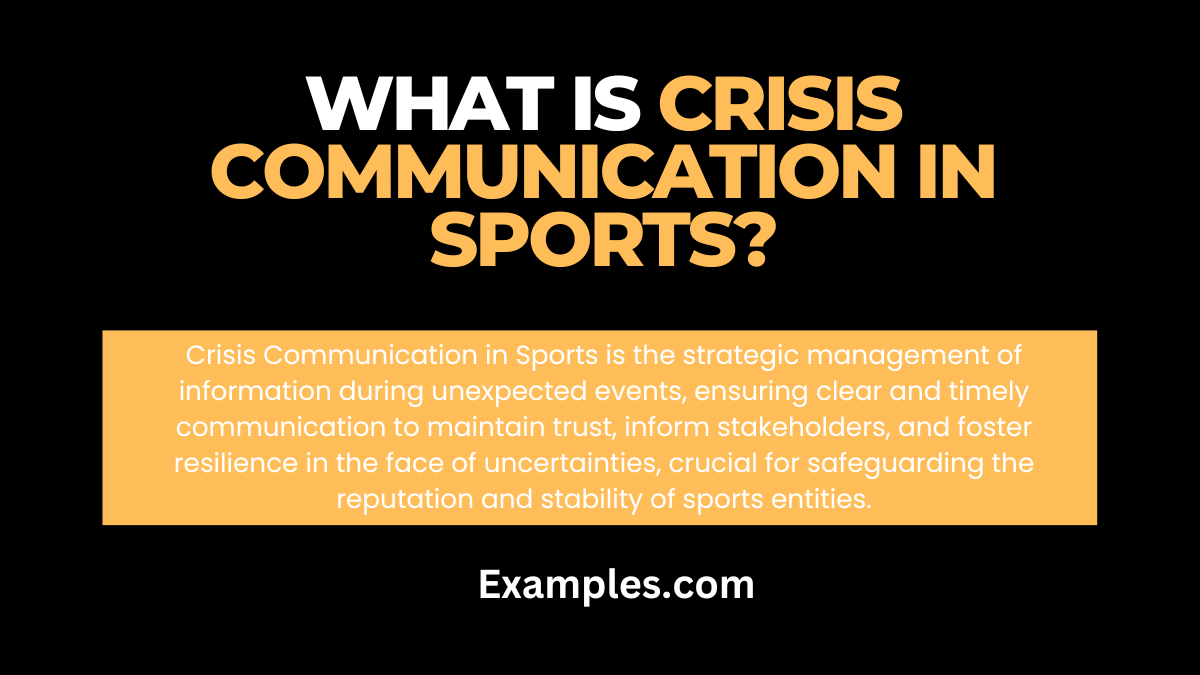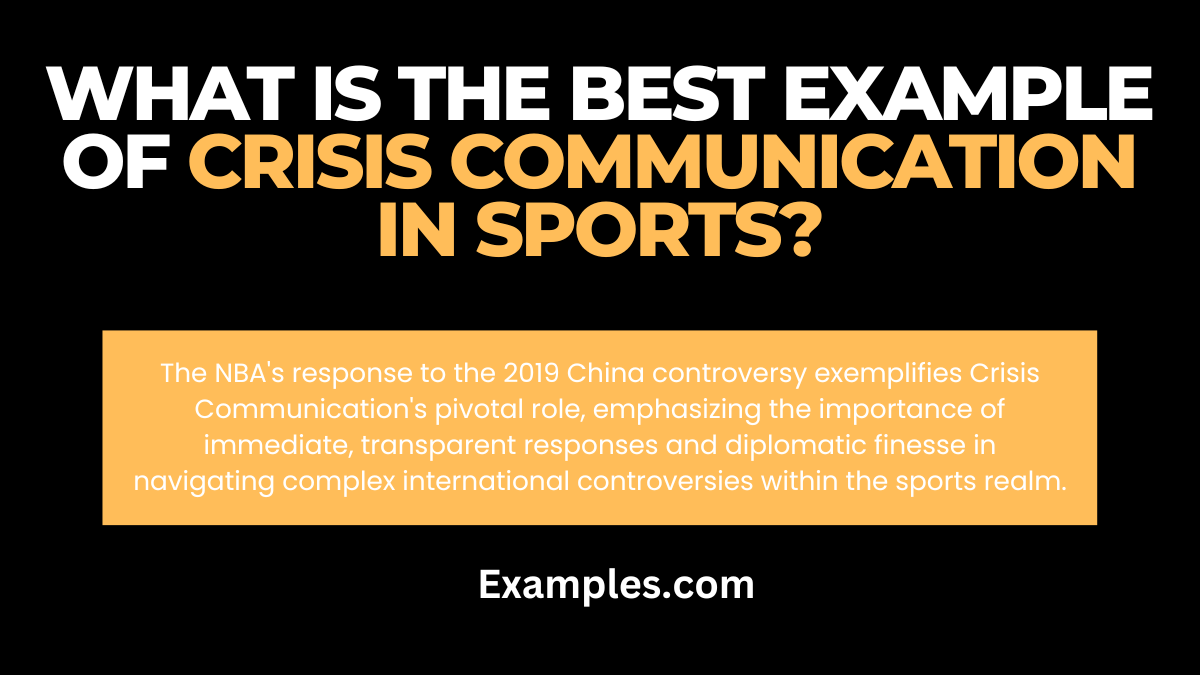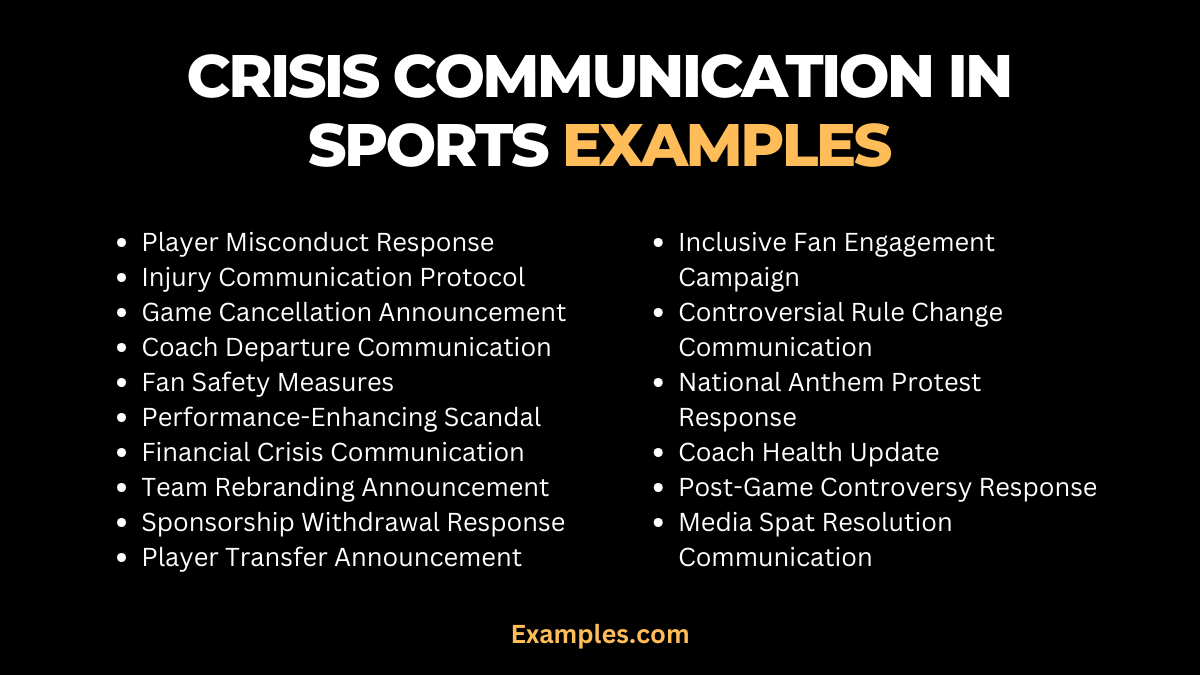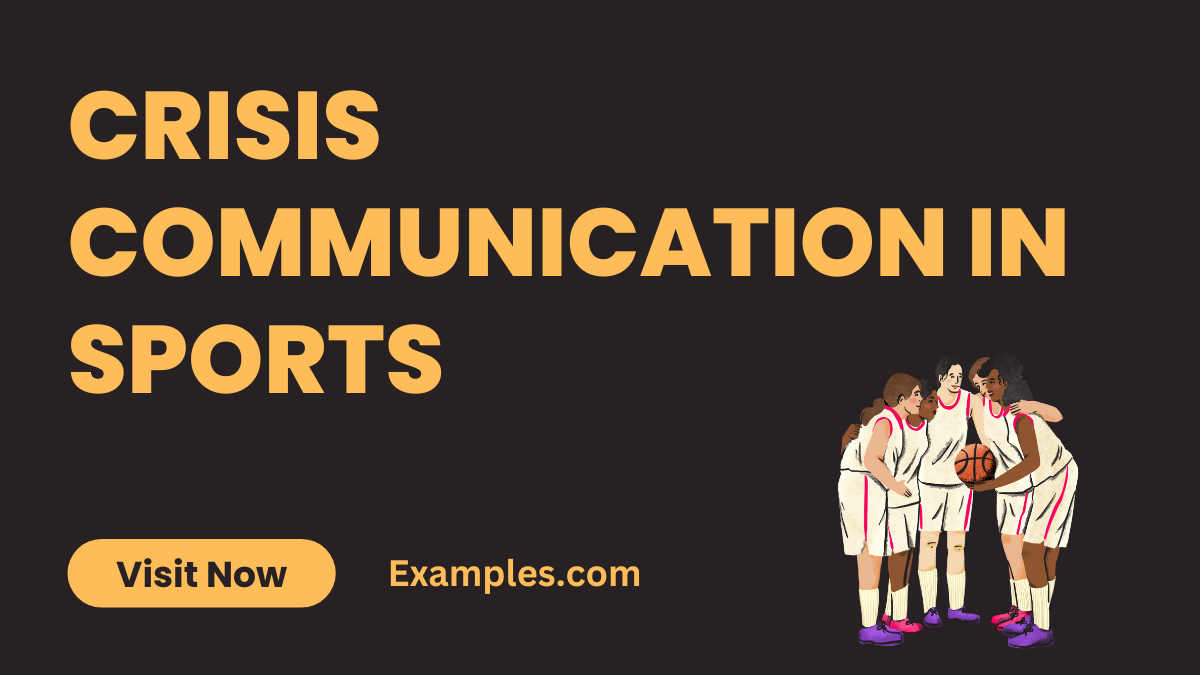19+ Crisis Communication in Sports Examples
Dive into the realm of Crisis Communication in Sports with our comprehensive guide, where we dissect real-world examples that showcase effective strategies. From handling unexpected challenges to maintaining public trust, this guide is your playbook for navigating uncertainties in the sports arena. Explore actionable tips, expert insights, and Communication Examples to bolster your crisis management toolkit and keep your team, fans, and stakeholders informed and engaged during challenging times. Score big with resilient and impactful communication strategies.
What is Crisis Communication in Sports?

Crisis Communication in Sports refers to the strategic process of managing and disseminating information during unexpected events or challenges in the sports industry. In simpler terms, it involves clear, timely communication to address and navigate uncertainties, ensuring stakeholders remain informed, trust is maintained, and the sports community stays resilient in the face of unexpected situations. This approach is crucial for safeguarding the reputation and stability of sports entities during crises.
What is the Best Example of Crisis Communication in Sports?

One standout example of Crisis Communication in Sports is the response to the 2019 NBA-China controversy. Fueled by a tweet supporting Hong Kong protestors, the NBA faced a diplomatic crisis. Swiftly, the league’s commissioner addressed the issue, acknowledging concerns, emphasizing freedom of speech, and bridging the gap. This case highlights the significance of immediate, transparent responses and diplomatic finesse, showcasing Crisis Communication’s pivotal role in navigating complex international controversies within the sports realm.
20 Crisis Communication in Sports Examples

Embark on a journey through 20 exemplar Crisis Communication instances in the sports world. Our guide provides SEO-friendly, NLP-friendly, and keyword-rich insights along with unique, distinct, and best examples.
- Player Misconduct Response: Swiftly address player misconduct with a clear stance.
Example: Clearly condemn the behavior, ensuring transparency and commitment to disciplinary action. - Injury Communication Protocol: Implement a transparent injury communication strategy.
Example: Share updates on player recovery, fostering trust among fans and stakeholders. - Game Cancellation Announcement: Clearly communicate reasons for game cancellations.
Example: Explain unforeseen circumstances, offering alternatives or rescheduling details. - Coach Departure Communication: Navigate coaching changes with transparent communication. Example: Share the departure news candidly, emphasizing the team’s commitment to a smooth transition.
- Fan Safety Measures: Communicate safety protocols for fans during crises.
Example: Outline enhanced security measures, ensuring a secure and enjoyable fan experience. - Performance-Enhancing Scandal: Address performance-enhancing scandals promptly.
Example: Convey a commitment to fairness and integrity, emphasizing strict adherence to anti-doping policies. - Financial Crisis Communication: Handle financial challenges with clarity.
Example: Communicate austerity measures while assuring stakeholders of long-term financial stability. - Team Rebranding Announcement: Introduce team rebranding with strategic communication.
Example: Articulate the reasons for rebranding, building excitement for the team’s new identity. - Sponsorship Withdrawal Response: Manage sponsor withdrawal with transparent communication. Example: Express gratitude to the departing sponsor, outlining plans to secure new partnerships.
- Player Transfer Announcement: Handle player transfers with openness.
Example: Announce transfers positively, emphasizing the team’s commitment to strategic roster changes. - Inclusive Fan Engagement Campaign: Foster inclusivity through fan engagement campaigns.
Example: Launch initiatives that celebrate diversity, ensuring all fans feel valued and represented. - Controversial Rule Change Communication: Address controversial rule changes with clarity.
Example: Explain rule modifications transparently, highlighting the benefits and rationale behind the decisions. - National Anthem Protest Response: Respond to player protests during the national anthem thoughtfully. Example: Acknowledge player concerns, affirming the team’s commitment to social justice initiatives.
- Coach Health Update: Provide updates on a coach’s health with empathy.
Example: Share health updates sincerely, expressing support for the coach’s recovery and well-being. - COVID-19 Protocol Communication: Communicate COVID-19 protocols effectively.
Example: Clearly outline safety measures, ensuring compliance to protect players, staff, and fans. - Post-Game Controversy Response: Address controversies arising from games promptly.
Example: Release a statement addressing the issue directly, committing to fair investigation and resolution. - Media Spat Resolution Communication: Resolve media conflicts transparently.
Example: Communicate resolutions to media disputes openly, emphasizing a commitment to constructive dialogue. - Weather-Related Event Communication: Navigate weather-related disruptions with clear communication.
Example: Inform fans about weather-induced changes, emphasizing safety and alternative arrangements. - Social Media Crisis Management: Manage social media crises strategically.
Example: Respond to controversies online diplomatically, emphasizing the organization’s commitment to positive engagement. - Player Retirement Announcement: Handle player retirements with sensitivity.
Example: Share retirement news with gratitude, celebrating the player’s contributions and future endeavors.
Crisis Communication in Sports for College Students Examples
In the realm of college sports, effective Crisis Communication is crucial for navigating unique challenges. Discover strategies tailored for college students, ensuring transparent and empathetic communication during crises.
- Campus Event Cancellation Communication: Address event cancellations with clarity.
Example: Share information about cancellations, providing alternative engagement options for college students. - Student-Athlete Injury Management: Communicate athlete injuries effectively.
Example: Clearly outline recovery plans, assuring college students of the athlete’s well-being. - Team Travel Disruptions Communication: Manage travel disruptions with transparency.
Example: Inform college students about changes, ensuring they are prepared for alterations to team travel plans. - Positive Drug Test Response: Address drug test results with empathy.
Example: Communicate corrective actions, promoting accountability among college athletes. - Inclusive Sports Program Announcement: Promote inclusivity in sports programs.
Example: Announce programs that cater to diverse interests, fostering a sense of belonging among college students.
Crisis Communication in Sports for Schools Examples
Effective Crisis Communication in school sports is paramount for maintaining trust. Explore strategies tailored for educational settings, ensuring transparent and empathetic communication during challenging situations.
- Weather-Related Event Communication: Navigate weather-related disruptions with clear communication.
Example: Clearly inform students about weather-induced changes, emphasizing safety and alternative arrangements. - Academic Eligibility Controversy Response: Address academic controversies transparently.
Example: Communicate corrective measures, ensuring fairness in school sports programs. - Sports Program Budget Cut Impact Communication: Address budget cuts transparently.
Example: Outline the impact on sports programs, fostering understanding and collaborative solutions among students. - Parental Concerns about Team Safety Communication: Respond to parental concerns about team safety.
Example: Address concerns with empathy, outlining safety measures to reassure parents. - Rescheduling Game Due to Facility Issues Communication: Communicate game rescheduling due to facility issues.
Example: Clearly explain changes, ensuring students and parents are informed and supportive.
Importance for Crisis Communication in Sports?
Crisis Communication is paramount in the sports domain, offering indispensable benefits for organizations navigating challenges. Here’s a succinct breakdown of its importance:
- Preserving Stakeholder Confidence:
- Fosters trust among fans, sponsors, and governing bodies.
- Crucial for sustaining support and engagement.
- Safeguarding Brand Reputation:
- Proactively manages and protects brand reputation.
- Mitigates potential damage during crises.
- Navigating Media Scrutiny:
- Empowers organizations to control narratives during crises.
- Ensures accurate representation in the media.
- Prioritizing Athlete Well-Being:
- Places emphasis on the mental and physical well-being of athletes.
- Establishes a supportive culture during challenging times.
- Retaining Fan Loyalty:
- Engages fans transparently and empathetically.
- Retains loyalty and support even amidst uncertainties.
- Preserving Sponsor Relationships:
- Maintains positive relationships with sponsors and partners.
- Ensures ongoing support and collaborations.
- Strategic Social Media Engagement:
- Leverages social media for effective Crisis Communication.
- Maintains a positive online presence during crises.
- Legal and Ethical Considerations:
- Navigates legal and ethical dimensions of crisis management.
- Ensures compliance with regulations and upholds ethical standards.
What are the issues for Crisis Communication in Sports?
Crisis Communication in sports presents unique challenges that demand a nuanced approach. Explore the intricacies of addressing these issues to effectively manage crises in the sports domain:
- Player Misconduct and Personal Issues:
- Strategies for handling player misconduct, personal controversies, and legal issues to safeguard the reputation of both athletes and the organization.
- Team Performance and Expectation Management:
- Addressing challenges related to poor team performance, unexpected losses, and fan expectations to maintain support during tough times.
- Injuries and Health Concerns:
- Communicating transparently about athlete injuries and health issues, balancing the need for information with considerations for privacy and sensitivity.
- Financial Strain and Budget Cuts:
- Managing crises stemming from financial challenges, including communicating austerity measures, budget cuts, or financial restructuring effectively.
- Scandals and Controversies:
- Strategies for handling scandals and controversies promptly and transparently to control the narrative and mitigate reputational damage.
- Facility-Related Challenges:
- Communicating during crises related to sports facilities, such as closures, disruptions, or safety concerns, while maintaining clarity and reassurance.
- Social Media Backlash and Online Controversies:
- Dealing with crises originating from social media, addressing negative narratives, and managing the impact of online controversies on the organization’s image.
- Legal and Compliance Issues:
- Navigating crises involving legal issues or compliance challenges, ensuring transparent communication to address concerns from fans and stakeholders.
Tips for Effective Crisis Communication in Sports?
Navigating crises in the dynamic world of sports requires a strategic and effective Crisis Communication approach. This comprehensive guide offers expert tips to enhance Crisis Communication in the sports domain, ensuring organizations handle challenges with poise and maintain trust.
- Swift and Transparent Communication:
- Explore the importance of immediate and transparent communication to address crises promptly and maintain trust among stakeholders.
- Establishing a Crisis Communication Team:
- Learn how to assemble a dedicated Crisis Communication team with defined roles and responsibilities to streamline communication efforts during crises.
- Preparedness and Scenario Planning:
- Delve into the significance of proactive preparedness, including scenario planning, to anticipate potential crises and respond with agility.
- Utilizing Social Media Effectively:
- Understand the nuances of Crisis Communication on social media platforms, leveraging these channels to disseminate accurate information and control narratives.
- Empathy and Support for Athletes:
- Learn strategies to prioritize athlete well-being, providing empathetic support and transparent communication during challenging times.
- Collaboration with Stakeholders:
- Explore the benefits of collaborative communication with stakeholders, including fans, sponsors, and governing bodies, to foster a united front during crises.
- Legal and Ethical Considerations:
- Navigate the legal and ethical dimensions of Crisis Communication, ensuring compliance with regulations and upholding ethical standards.
- Strategic Media Engagement:
- Learn how to strategically engage with media outlets to manage the narrative effectively, providing accurate information while preserving the organization’s interests.
In conclusion, effective Crisis Communication in sports is paramount for maintaining trust, preserving reputations, and navigating challenges. This comprehensive guide provided insights, strategies, and real-world examples to empower sports organizations in handling crises with transparency and agility. By embracing these principles, organizations can fortify their resilience, engage stakeholders effectively, and emerge stronger from unforeseen challenges in the dynamic realm of sports.



